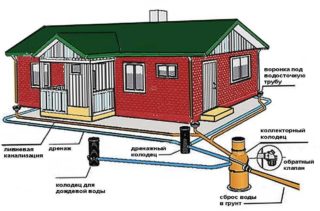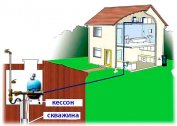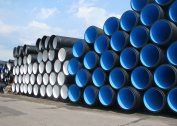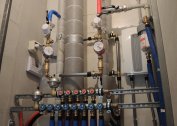If puddles do not dry out in the spring and autumn for weeks on the plot, there is water in the basement of the house, fruit trees and garden plants do not grow, but horse sorrel and reeds feel fine, then the soil is excessively saturated with moisture. High humidity is the cause of various diseases. The installation of a drainage system around the house will help to reduce the water content of the soil. A competently created system will work for many years, creating a comfortable environment.
Types and arrangement of drainage systems
 To protect the site from waterlogging, it is necessary to organize the diversion of excess water from the adjoining territory that comes with precipitation or accumulates at the ground surface due to the high level of groundwater. During construction, the price for the installation of a drainage system for the house will be determined:
To protect the site from waterlogging, it is necessary to organize the diversion of excess water from the adjoining territory that comes with precipitation or accumulates at the ground surface due to the high level of groundwater. During construction, the price for the installation of a drainage system for the house will be determined:
- destination;
- the depth of the drain;
- length and method of organizing drainage channels.
Depending on the depth of pipe placement, drainage can be:
- deep - removes groundwater;
- surface - to drain rain or melt water.
Installation of a surface drainage system is carried out linearly around the country house, or pointwise in places of accumulation of water. In the case of large water cuts, it is optimal to combine the two options into a single system. The device of point drainage includes: water inlets, drain pipes or trays with decorative grilles, drainage wells. Linear consists of trays (gutters) with gratings as covers, water inlets, sand traps made of durable frost-resistant materials.
The drainage system for a private house is being built in places of the greatest accumulation of water. The device includes: a complex of drains, canals, wells and other drainage facilities. Drainage includes horizontal or vertical components. For irrigated areas, the optimal installation of combined options for the drainage system, the constituent parts of which sets the price and amount of work. The following types of drainage are available:
- formation: constructed between the aquifer of the soil and the foundation pillow of the building; protects the basement of the house from groundwater, and the foundation from the absorption of moisture from the surrounding soil;
- wall: laid along one wall or along the perimeter of the building close to the foundation deeper than its lower boundary. The main task of installing the drainage system on the site in this case is to prevent water from reaching the foundation of the house, and using intercepting channels to divert it outside the territory;
- annular: the drainage system covers a certain contour; the price of work depends on the length of the structure; the location of the ring drainage is regulated by the distance to the house (should be no closer than 5 m), the depth of freezing of the soil, the lower boundary of the foundation (laid 0.5 m deeper); the installation of an annular drainage system on the site regulates the level of groundwater inside the circuit, creates comfortable conditions for living or growing plants;
- vertical: water-reducing wells equipped with drainage pumps, designed to control the level of groundwater, as well as manholes for servicing drains; according to the standards, the wells are installed in places of turns, slopes, changes in the track, as well as at the lower and upper points of the system; the distance between two wells should not exceed 50 meters.
Simultaneously with the choice of the type of drainage on the site, it is necessary to decide where the discharged water will be discharged. A rash approach to drainage can lead to waterlogging of the neighboring territory.
Phased installation technology of the drainage system around the house and on the site
The work to create a comfortable environment on our land consists of several stages.
Design
The construction of a drainage system on a site, regardless of the price of the work, must be preceded by a project. This is important even if you intend to dig a drainage well or ditch on your own. It is necessary to take into account many parameters: location, distance, slope of the site for calculating the initial and final depths of the trench. In order for water to move by gravity, the height difference must be at least 5 mm per 1 m.
Installation of a drainage system of any type is associated with the excavation and displacement of a large amount of soil, therefore, it should be planned at the stage of building a house, before carrying out landscaping and planting.
Preparation of tools and materials
Based on the project, the necessary materials are prepared in the right amount:
- pipes (corrugated flexible or rigid);
- trays, grates, connecting rings, tees, fittings, plugs;
- geosynthetic filters (textiles);
- drainage plastic wells and covers for them;
- concrete or cement, sand, crushed stone or polyethylene filler.
Drainage should stand for several decades, so it is advisable to choose high-quality materials for its construction.
The installation of the drainage system is not complicated, but time-consuming, phased technology requires a lot of effort and time. In addition, if the work is carried out on its own, it is necessary to prepare the tools:
- spade bayonet, pick;
- construction level;
- measuring tape;
- pegs, twine for marking;
- wheelbarrow for transportation of soil or gravel;
- hacksaw for metal;
- manual tamper.
Invited specialists, as a rule, carry tools and accessories for work.
Installation
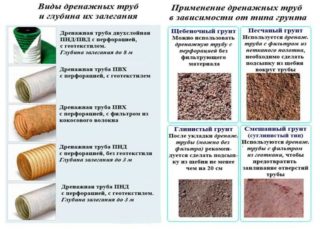 Installation works of the drainage system on the site are carried out in accordance with the selected option of the drainage system.
Installation works of the drainage system on the site are carried out in accordance with the selected option of the drainage system.
Installation of spot drainage:
- At water collection points (for example, under the gutters), pits are excavated according to the dimensions of the water receiving device with a small margin.
- At the bottom, a concrete pad 10 cm thick is created on which a water intake is installed. It should be located below the ground or blind area by 0.5 cm, taking into account the thickness of the gratings. This is done so that the water from the drain or the surrounding area easily gets into the drain.
- The water intake pipe or trays of the drainage system is connected to a drive or sewer.
- The free space between the wall of the plastic conduit and the trench is filled with concrete to give rigidity to the structure.
- Decorative grilles are installed.
Linear surface drainage
- In accordance with the project, lines of future drainage are outlined with pegs and twine. Taking into account the necessary slope, trenches are digging under the trays with a margin of depth, 10 cm wide.
- The bottom of the channel is compacted, a concrete pad 10 cm thick is created. Trays are installed on it, as well as a sand trap at the lower point. Parts tightly fit along the grooves, the direction is indicated by arrows. Installation is controlled by the building level. When connecting the trays with a sand trap and further with a drainage well, adapters are used. To insert them, it is necessary to remove the plug from the prepared hole or to make a hole with a chisel in the right place. If necessary, joints are treated with sealant.
- Concrete is filled in the empty space between the wall of the trench and the tray. To avoid deformation of the channels, you need to put in place wrapped with polyethylene (to maintain cleanliness) decorative grilles.
After the concrete has hardened, they fill the soil or lay a rolled lawn along the edges of the trays. Lattices free from film.
Cost of work
The cost of installing a drainage system is the sum of the cost of materials and work on moving the soil.
The price of work increases significantly with increasing depth of drainage. A running meter of a storm system laid on a surface costs from 300 rubles. with materials; work on the arrangement of deep drainage is much more expensive - from 1500 rubles. up to 6000 rub. depending on the depth.
Various companies offer to carry out work on the organization of the drainage system from the preparation of the project to the landscaping. For example, one of the companies in the Moscow Region offers a turnkey installation of a drainage system around a house at a price of 15 hundred parts at a price of 345,000 rubles. taking into account materials and work.
| Drainage Option | Moscow | Khabarovsk | Kaliningrad |
| rainfall | from 650 rub. for m | from 300 rub. for m | |
| surface depth 0.5 - 1 m |
from 950 rub. per running meter | 1155 rub. for m | 800-900 rub. for m |
| deep wall depth from 1 m to 2.5 m |
2000 - 5000 rub. for m | from 1500 rub. for m | from 4000 rub. for m |
| deep ring depth from 1 m to 3 m |
2000 - 6000 rubles. for m | from 1500 rub. for m | from 1200 rub. for m |
You can purchase the necessary materials and independently carry out all earthwork. This will take a lot of time, but save a large amount. The main thing is to think through everything to the smallest detail so that you do not have to redo it.

